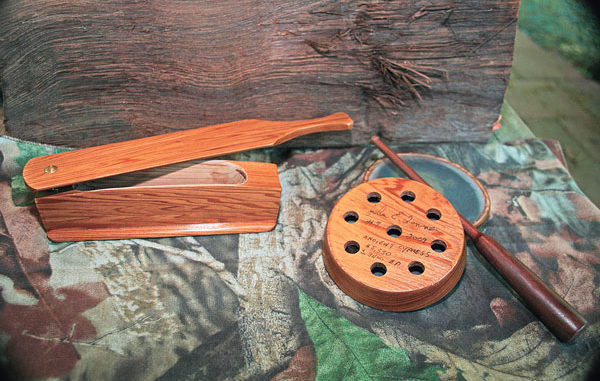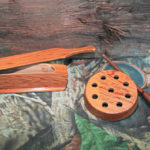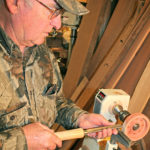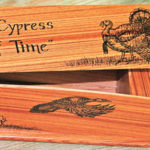
Ancient cypress in call-maker’s boxes aged at 45,990 years.
When you hold a box call made of ancient cypress and run a few turkey calls on it, there is no escaping the thought: Did turkeys actually exist when the tree this wood came from was growing in South Carolina’s Pee Dee region?
John Tanner’s calls are made of wood from cypress trees that grew along the Lynches and Pee Dee Rivers nearly 50,000 years ago.
“I have pondered that question a million times while working a piece of wood, studying the grain pattern and thinking about what the earth was like back then,” said Tanner, who lives in the tiny Williamsburg County community of Indiantown. “I wonder what wildlife looked like then. That was in the middle of the last Ice Age. I think about the wooly mammoth and saber-toothed tigers playing around those trees and wonder if wild turkeys existed 40,000 to 50,000 years ago, and if so, what did they look like?
The ancient cypress logs were uncovered at a sand mine near Johnsonville. Considered a nuisance to the mining operation, many were burned before a visitor took a piece of the wood home, dried it and used a grinder to craft a beautiful wood bowl. The wood was carbon-dated at the University of Georgia to verify when the trees fell into the river and were covered by sand.
Tanner’s transformation from a retired computer-systems manager to a turkey-call maker is entwined with the remarkable story of the ancient cypress trees with the beautiful grain patterns. It began one night when the folks involved in Ancient Cypress LLC were discussing how different artisans were going to use the elegantly-patterned wood in their craft. Tanner was helping the company with public relations on a volunteer basis.
“Out of the clear blue sky, I said, ‘Don’t give anybody the rights to make turkey calls. That will be my pay’,” he recalled. “I had never made a turkey call in my life, but I bought a few pieces of wood-working equipment and started playing around with the wood.”
Tanner discovered soon after he had started John Tanner Turkey Calls that some inherent problems exist with the ancient cypress as far as making turkey calls. The wood is somewhat soft and hard to work to the point where the box will produce a true-sounding call.
“It took me two to three years to come up with something I thought was a realistic call that I liked the sound of,” he said.
An avid turkey hunter since he first heard a gobbler respond to a guide’s call on a hunt in the early 1990s, Tanner (843-373-8434) took to making turkey calls with a passion.
His original ancient cypress calls were seven inches long and 1¾ inches wide. Following the advice of several prominent callmakers and collectors, he shortened the next generation of calls to 6½ by 1½ inches.
“You would not believe the difference it made in the call — in the esthetics, in the way the call looked, the way it felt in the hand and, to a great extent, to the sound quality. It certainly made a major difference in how the public reacted to (them),” Tanner said.
As demand grew, Tanner began to branch out, working with walnut, mahogany and red cedar, making different kinds of calls and innovating with the box call.
The first step was producing pots on a lathe for slate calls. One year, while exhibiting at the Palmetto Sportsmen’s Classic in Columbia, his booth was located next to call-maker David White of Virginia, who demonstrated hand-held trough calls — a hollow wooden bed with a strip of slate, worked with a wooden striker.
“He was selling those trough calls as fast as he could put them out on the table. I fell in love with the call, the sound, the look and how it fits in your hand,” said Tanner, who swapped one of his box calls for a White trough call.
As Tanner began making trough calls, he began to think of a way to get a similar sound from the side of one of his box calls. The answer came at 4 o’clock one morning in November 2009.
“I sat straight up in the bed. The idea, which came in my sleep, was to put the slate on the left side of the box and drill a hole in the end to store the striker,” he said.
Tanner began working on his idea that morning, creating two or three different calls and testing them.
“By George,” he said, “it sounded pretty good.”
With modifications, he began producing what he dubbed the “Double Play Call.”
“You get the standard sound on the right side of the box, and once you learn to hold the call in your hand and rotate the paddle, it is relatively easy to produce a fighting cackle and purr on the slate side,” he said.
The demand for his ancient cypress calls continues to grow. Tanner is currently is working with a 6-foot cypress log that has been carbon dated at 45,990 years old, plus or minus 400 years. Each call he makes from that log comes with a certificate authenticating the age of the wood and a photo of Tanner with the cypress log.
“In everything I do, I look for beauty in the knot pattern of the wood or a special grain pattern, and I will build that into the call so it can be enjoyed and appreciated,” he said. “As for the sound, I know what I’ve heard in the woods over all these years. I know instantly whether a call sounds right to me and what I think a turkey is listening for.”
Each day, he said, he enters his little shop with renewed enthusiasm for the hobby that has turned into a full-time profession.
“Every single call I build, I think, ‘Boy, this is going to be the best call I ever made — the best looking and the best sounding.’ Then, when that call works really well, I pick up another piece of wood and, all of a sudden, that call is going to be the best I ever made.”






Be the first to comment